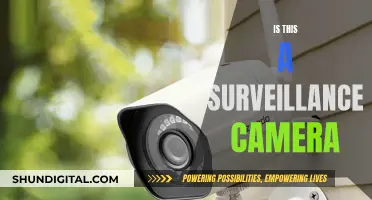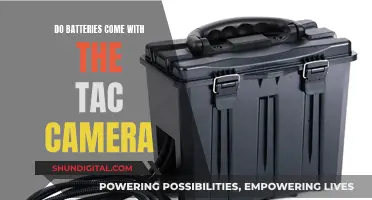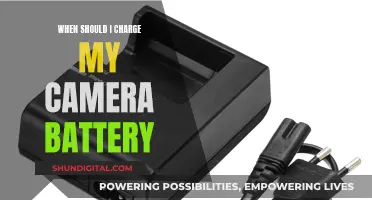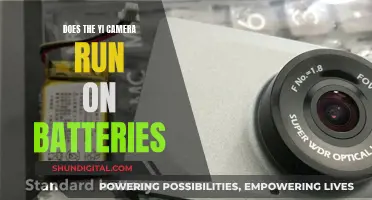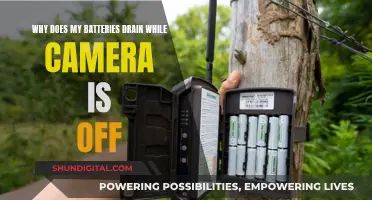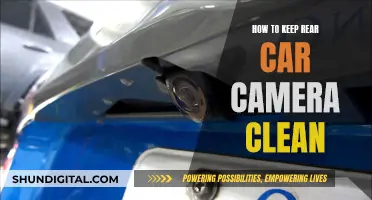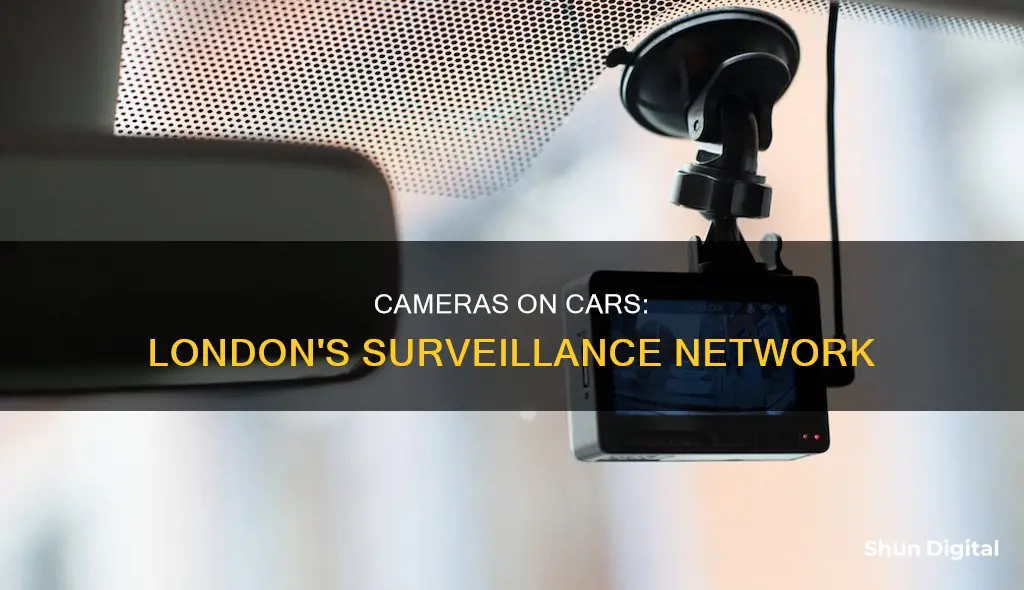
London is known for its extensive surveillance network, with CCTV cameras on almost every corner. While the exact number is hard to pinpoint, current estimates suggest there are around 950,000 CCTV cameras in London, making it one of the most surveilled cities in the world. In addition to these public cameras, there are also private cameras operated by businesses and homeowners, with estimates suggesting that there could be up to 70 times more private cameras than public ones. London also has Ultra Low Emission Zones (ULEZ) monitored by cameras to charge drivers of vehicles that do not meet emission standards. As of 2023, there were 1,775 ULEZ cameras installed, with a planned total of 2,750.
| Characteristics | Values |
|---|---|
| Number of ULEZ cameras in London | 1,775 out of a planned 2,750 |
| Number of CCTV cameras in London | 691,000-950,000 |
| Number of CCTV cameras owned and operated by public bodies in London | 23,708 |
| Number of CCTV cameras on the London Underground network | 15,576 |
What You'll Learn

London's Ultra Low Emission Zone (ULEZ)
The ULEZ scheme charges a daily fee of £12.50 for cars, motorcycles, vans, and specialist vehicles (up to and including 3.5 tonnes) and minibuses (up to and including 5 tonnes) that do not meet the ULEZ emissions standards. This fee must be paid by midnight on the third day following the journey. Owners of non-compliant vehicles can check their vehicle's emissions standards using an online checker tool and register their vehicles with the appropriate authorities.
Lorries, vans, and specialist heavy vehicles over 3.5 tonnes, as well as buses, minibuses, and coaches over 5 tonnes, are exempt from the ULEZ charge. However, they must pay the Low Emission Zone (LEZ) charge if they do not meet the LEZ emissions standards. The LEZ covers most of Greater London and costs £100 per day.
The ULEZ was first introduced in a small, central area of London, overlapping with the London Congestion Charge zone. In October 2021, the ULEZ was expanded significantly to include areas within the North and South Circular ring roads. As of 29 August 2023, the ULEZ has been expanded again to cover almost all areas inside the M25, impacting millions of car and van drivers.
The ULEZ scheme aims to reduce harmful emissions and improve air quality in London. Research has shown that poor air quality, mainly caused by polluting vehicles, is detrimental to the health of Londoners, contributing to illnesses such as cancer, asthma, and lung disease. By encouraging the use of cleaner and more efficient vehicles, the ULEZ helps reduce the number of pollution-related deaths and promotes the use of public transport.
Breaking Surveillance Cameras: Effective Strategies for Privacy Protection
You may want to see also

ULEZ cameras and how they work
ULEZ, or Ultra Low Emission Zone, is a term that has been gaining traction in metropolitan areas, with London being a prominent example. The ULEZ camera system, overseen by Transport for London (TfL), is a critical component in enforcing the Ultra Low Emission Zone. These advanced cameras are strategically positioned throughout the city to capture the number plates of vehicles entering and exiting the ULEZ.
The data captured by the ULEZ cameras undergoes rigorous scrutiny. The recorded number plates are cross-referenced with a comprehensive database to determine whether the vehicle meets the stringent ULEZ standards. This process allows the system to identify vehicles that emit high levels of pollutants, ensuring compliance with emission regulations.
If a vehicle is found to be non-compliant, the driver incurs a daily charge, which must be paid within a specified timeframe to avoid penalties. The ULEZ cameras not only serve as surveillance tools but also reflect London's commitment to environmental sustainability. By enforcing strict emission standards, these cameras play a vital role in reducing harmful pollutants, contributing to a cleaner and healthier urban environment.
The implementation of ULEZ cameras brings forth several benefits. Firstly, they help improve air quality by monitoring and penalising vehicles emitting high levels of pollutants. This, in turn, leads to a tangible improvement in the air quality of urban areas, benefiting the health of residents, especially vulnerable groups such as children and the elderly. Secondly, ULEZ cameras encourage the adoption of environmentally friendly transportation options by incentivising individuals and businesses to invest in low-emission vehicles, electric cars, and public transportation. This shift contributes to a reduction in individual carbon footprints and the mitigation of climate change.
In London, there are approximately 2,800 ULEZ cameras located across the city, with a focus on roads leading to the entrances of the ULEZ zone. While the exact locations of these cameras are not publicly disclosed by TfL, independent entities have created maps to provide clarity on active camera locations. The ULEZ camera system operates 24 hours a day, 7 days a week, with Christmas Day being the only exception.
Correcting Warping: Camera Raw's Superpower
You may want to see also

Vandalism of ULEZ cameras
The Ultra Low Emission Zone (ULEZ) scheme in London, which aims to reduce vehicle exhaust emissions by 46% in central London, has faced significant opposition from anti-ULEZ Londoners. This opposition has manifested in the form of vandalism, with countless numbers of ULEZ cameras across the capital being destroyed or vandalised. The vandalism includes cutting down cameras and traffic lights, with some protesters even putting Christmas trees in the ULEZ camera poles.
Local residents in Orpington, for example, have expressed mixed reactions to the ULEZ camera vandalism. While some support the destruction of the cameras, others worry about the cost of repairs and the potential impact on road safety. One resident, Matt McConnell, commented on the irony of the situation, stating that "it is costing the taxpayer even more money to repair the broken cameras."
The vandalism has also caught the attention of the media, with local journalist Matt Hardy documenting the wreckage of ULEZ cameras and traffic lights in Hillingdon, London. In his video, Hardy showcases the extent of the damage, with smashed glass and plastic strewn across the ground, and even a crude St George's Cross smeared over one of the camera lenses.
The campaign group behind the vandalism calls itself the "Blade Runners". The group has been active since the ULEZ scheme was expanded to Greater London in the summer of 2023. They have targeted not only the cameras but also vans used by ULEZ enforcement teams.
The Information Commissioner's Office (ICO) has blocked the release of repair cost information to the public, citing that disclosing the sums might encourage more vandalism. Transport for London (TfL) has also refused to disclose information about the number of sabotaged cameras and the cost of repairs, stating that it would "adversely affect the course of justice" and "reduce the damage to our camera network."
Despite the vandalism, TfL has assured the public that the ULEZ scheme remains operational. A spokesperson stated that "camera vandalism will not stop the ULEZ operating London-wide" and that "all vandalised cameras are repaired or replaced as soon as possible."
HP Computers: Where's the Camera?
You may want to see also

CCTV in London: crime deterrence and property monitoring
London is known for its extensive CCTV network, which is one of the largest in the world. The city has over 500,000 cameras, with some estimates placing the figure at 809,000 or even 1 million. These cameras are strategically placed throughout the city, monitoring public areas, personal property, and vehicles. The advantages and disadvantages of such a large-scale surveillance system are highly debated.
Crime deterrence and detection
One of the primary purposes of London's CCTV network is to deter crime and assist in investigations. The presence of cameras can increase the actual and perceived risk of getting caught, making criminals less likely to commit offences. CCTV footage can also aid in solving crimes by helping the police identify and track down suspects, as seen in the Charlie Hebdo attack, the Boston Marathon bombing, and the 7th July attacks in London.
Studies have shown that CCTV is "associated with a statistically significant decrease in crime". In particular, drug-related crimes decreased by 20%, and vehicle and property crimes decreased by 14% in areas with CCTV compared to those without. The largest and most consistent effects were observed in car parks, where crime decreased by 37%, and in residential areas, where crime decreased by 12%.
However, it is important to note that violent crime was not affected by the presence of cameras. Additionally, there have been instances where CCTV footage has led to wrongful convictions due to poor-quality footage or unfavourable camera angles.
Traffic monitoring and management
In addition to crime deterrence and detection, CCTV cameras in London are used to monitor traffic conditions and direct drivers away from congested areas. This helps to reduce congestion and improve journey times. London's Ultra Low Emission Zone (ULEZ), for example, uses cameras to monitor which cars enter and exit the zone and to enforce a daily charge for vehicles that do not meet emission standards. As of January 2024, there were 1,775 ULEZ cameras installed, with more planned.
Privacy concerns
The extensive use of CCTV cameras in London has raised concerns about privacy and the impact of surveillance on individuals' rights. While some may view the network as an invasion of privacy, others argue that it is necessary for public safety. Under UK law, there is no general right to privacy in public places, and individuals cannot opt out of being filmed by CCTV cameras. However, privacy impact assessments (PIAs) can be conducted to identify and mitigate potential privacy risks.
In conclusion, London's CCTV network has both advantages and disadvantages. While it has been credited with deterring and solving crimes, as well as improving traffic management, it has also raised concerns about privacy and been implicated in wrongful convictions. As technology and surveillance continue to evolve, the debate around the use of CCTV will likely remain contentious, with new regulations needed to balance public safety and civil liberties.
Surveillance Cameras: A Reflection of Our Modern Society
You may want to see also

Public vs private cameras in London
London has a reputation for being one of the most surveilled cities in the world. While there is no clear data on how many cars in London have cameras, there are thousands of cameras across the city, with a mix of public and private surveillance.
Public Cameras in London
The UK government has a history of utilising mass surveillance, with a focus on intercepting electronic communications and the bulk collection of data. London's Ultra Low Emission Zone (ULEZ), implemented to reduce air pollution, is managed through the use of cameras that monitor vehicles entering and exiting the zone. These cameras record license plates and check them against a database to determine if a vehicle meets emission standards or requires a charge. As of 2024, there are 1,775 ULEZ cameras installed, with a planned total of 2,750.
In addition to the ULEZ cameras, London also has an extensive network of closed-circuit television (CCTV) cameras. According to 2021 research, there are approximately 23,708 CCTV cameras owned and operated by public bodies in London, including Transport for London, the Metropolitan Police, the City of London Council, and local authorities. This number also includes the 15,576 cameras on the London Underground network.
Private Cameras in London
While public cameras are prevalent in London, the majority of cameras in the city are privately owned and operated. A 2013 report by the British Security Industry Association (BSIA) estimated that there were between 4-5.9 million cameras in the UK, and by 2020, the estimated number of CCTV cameras in London was 691,000. This high number is attributed to the increasing use of private cameras by businesses and homeowners, who have access to low-cost home CCTV systems and smart doorbells. The BSIA estimates that privately-owned cameras outnumber publicly-owned ones by a ratio of 70 to 1.
Impact and Effectiveness of Surveillance Cameras in London
The presence of surveillance cameras in London has sparked debates about their impact on privacy and their effectiveness in reducing crime. On the one hand, surveys suggest that video monitoring can lead to a decrease in certain types of crime, such as drug-related crimes, vehicle crimes, and property crimes. However, violent crimes have not shown a significant decrease due to the presence of cameras. In these cases, camera footage becomes valuable for tracking down suspects after the incident.
The increasing use of private cameras has also raised concerns about privacy and the right to information. With private individuals and companies operating a significant number of cameras, questions arise about who owns and is responsible for the footage, especially in the event of a crime. The introduction of the EU's General Data Protection Regulation (GDPR) has addressed some of these concerns by imposing requirements on companies using CCTV regarding data storage, usage, and individual access to footage.
In conclusion, London has a complex mix of public and private surveillance cameras, with private cameras significantly outnumbering public ones. While public cameras, such as those for the ULEZ and CCTV networks, are more visible and often the subject of debate, private cameras have become increasingly prevalent and influential in both commercial and domestic settings. The balance between public safety, crime prevention, and individual privacy continues to be a critical consideration in the deployment and regulation of all forms of surveillance in London.
How to Ensure Your Camera Charges Efficiently While Switched Off
You may want to see also
Frequently asked questions
It is unclear how many cars in London have cameras. However, there are an estimated 950,000 CCTV cameras in London, and thousands of ULEZ cameras that monitor cars entering and exiting the zone.
ULEZ stands for Ultra Low Emission Zone. ULEZ cameras record the number plates of cars that do not meet emission standards and a daily charge is imposed on the vehicle's owner.
The purpose of ULEZ cameras is to reduce air pollution in London, which is linked to about 4,000 deaths per year.


